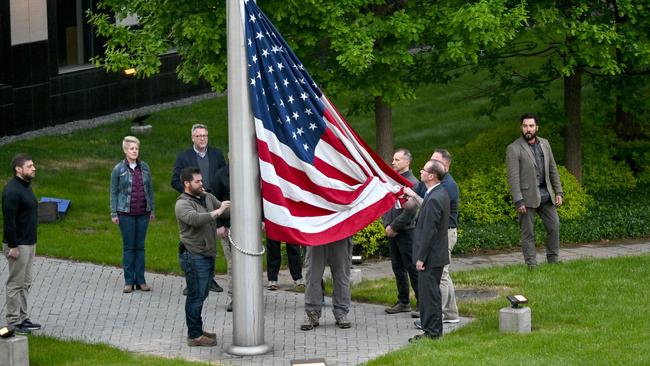Pentagon weighs deploying special Forces to guard Kyiv embassy
Administration weighs desire to avoid escalating military presence against security of US diplomats in a conflict zone.

US military and diplomatic officials are weighing plans to send special forces troops to Kyiv to guard the newly reopened embassy there, proposals that would force the Biden administration to balance a desire to avoid escalating the US military presence in the war zone against fears for the safety of American diplomats.
President Joe Biden has yet to be presented with the proposal. But if he approves it, troops would be deployed only for the defence and security of the embassy, which lies within range of Russian missiles, US officials said. Their presence inside Ukraine would mark an escalation from Mr Biden’s pledge no US troops would be sent into the country.
The administration seeks to balance concerns within the State Department that a robust, conspicuous security posture at the embassy could provoke Russian President Vladimir Putin with the need to deter a potential attack on American personnel – and have sufficient forces to extract them if fighting breaks out again in Kyiv.
Russia continues to target the Ukrainian capital with occasional airstrikes or shelling even as the city has begun to return to normal.
For now, the State Department will furnish its own security, from a corps of guards in the Diplomatic Security Service, for the embassy in Kyiv.
Preliminary planning is under way at the Pentagon and the State Department for possibly dozens of special forces troops who could augment security at the embassy, or could stand by to deploy if needed. In addition to using special forces troops to provide security at the embassy, officials are considering restoring a marine security guard detachment, like those that normally provide security at embassies around the world. No formal proposals have been sent so far to Defence Secretary Lloyd Austin, chairman of the Joint Chiefs of Staff Mark Milley or Mr Biden.
“We are in close touch with our colleagues at the State Department about potential security requirements now that they have resumed operations at the embassy in Kyiv,” said Pentagon spokesman John Kirby. “But no decisions have been made, and no specific proposals have been debated at senior levels of the department about the return of US military members to Ukraine for that or any other purpose.”
Over time, and depending on how the conflict in the east unfolds, American officials envision a larger presence for the US to administer the tens of billions of dollars of weaponry that have poured into the country. And some US military officials would like to return to Ukraine the special forces and other troops that were training and advising the Ukrainian military.
The embassy in Kyiv was all but shut by the time Russia invaded Ukraine on February 24, its diplomatic staff largely relocated 550km west to Poland, with a small group making short trips to a makeshift diplomatic post in Lviv, just inside the Ukraine border.
After Mr Putin failed to achieve a key objective of taking Kyiv and installing a puppet government, Russian forces have shifted operations to the east. In late March, Russian forces began to focus on the Donbas region.
Although Kyiv remains under threat of artillery and missile fire, several key US allies have reopened their embassies or returned to Kyiv diplomats.
The State Department has already begun to lean on the US military for security.
On May 8, Kristina Kvien, the senior diplomat in the US mission to Ukraine, and a small group of diplomats temporarily based in Poland returned to the embassy in Kyiv to commemorate Victory in Europe Day. They were escorted by special forces assigned from Joint Special Operations Command in Fort Bragg, New Carolina – the first known instance in which US forces entered the country since the invasion.
Last Wednesday, the US flag was raised at the embassy. Secretary of State Antony Blinken said the department had “put forward additional measures to increase the safety of our colleagues who are returning to Kyiv and have enhanced our security measures and protocols”. The initial contingent of US diplomatic personnel will be small.
Officials see as unlikely an attack on the embassy like the 2012 assault on a diplomatic outpost in Benghazi, Libya, that killed four Americans including the top diplomat. But they are generally uneasy about sending American diplomats into an active war zone.
Also weighing on officials is the evacuation of the Kabul embassy last year. As the Taliban was taking control of Afghanistan, the Pentagon urged the State Department to reduce the size of the embassy, which stood at more than 4000 people. State Department officials hesitated, determined to maintain a robust mission in Kabul despite the deteriorating security situation. In August, troops evacuated the remaining US diplomats to Kabul’s airport, where some continued to work through the chaotic last days of the mission there.
The Wall Street Journal



To join the conversation, please log in. Don't have an account? Register
Join the conversation, you are commenting as Logout